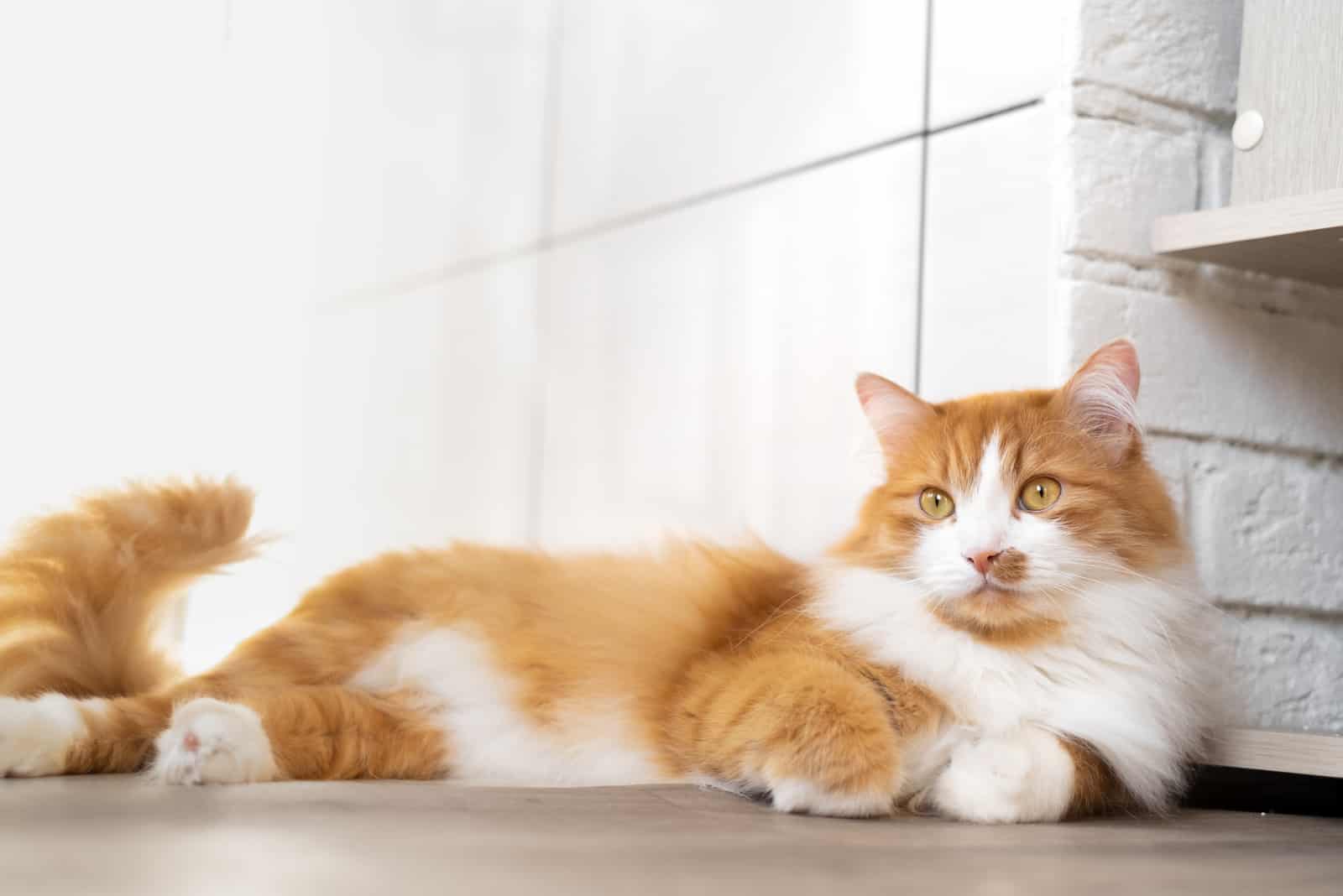How Long Does It Take A Cat To Adjust To New Home? Explained

You might be moving into a new house or perhaps you have just adopted a new cat. Just like any caring pet owner, you will likely be wondering How long does it take a cat to adjust to new home?
It is a valid question. The short answer is: If we are talking about a kitten, it will only take a few days, while for grown cats it can take about a week or a bit more.
It is well-known that new environments can cause stress in cats and this is something we certainly don’t want. Fortunately, there are ways to make your cat’s transition period easier and hopefully, quicker.
How Long Does It Take A Cat To Adjust To New Home?

There are two things to take into consideration when answering this question:
• The cat’s age
• Whether it is a domestic cat or a stray cat
Kittens adapt the quickest by far, taking from 2 to 5 days maximum.
If the cat is a domestic cat older than 1 year old, it can take anywhere from 3 days up to a week. For domestic cats that are a bit older, it can take anything from a few days to a few weeks.
Why Do Some Cats Adjust Quicker And Some Don’t?
When you think about it, the adjustment times make sense.
New kittens don’t have a strong sense of territory yet, so changing environments is not a big issue. However, for adult cats that are very territorial, it can be a bigger issue.
Stray cats also take longer to adapt, in comparison to domestic cats. This is to be expected since the change of environment for domestic cats is not as drastic.
Stray cats are completely changing their surroundings and lifestyle, so it is normal that they may take a week or more to adapt compared to their same-aged domestic cat friends.
Either way, every cat will eventually adapt (hopefully will do it quickly with your help), so don’t be overly concerned about it!
Is There The “Right” Amount Of Adjustment Time?
There really are no specific rules for how long does it take a cat to adjust to new home.
There is certainly no “ proper“ or “right“ amount of time. All cats are different and they all adapt at their own rate.
You might be surprised by your cat deviating from the expected adjustment time – a stray cat adjusting in just a day or a younger domesticated cat taking weeks.
With this being said, there are a couple of things you can do to make their transition smoother and quicker. Later, we will look at a few tried and tested ways that you can reduce the adjustment time by a couple of days (or even weeks for strays and older domestic cats).
6 Signs Your Cat Is Not Happy About The New Surroundings

Unusual behaviors that can be noticed in cat adjusting to a new home following a move include:
1. Hiding
This is by far the most common sign. You may notice your pet frequently hiding under chairs, tables, and beds, as if it is scared of something. This is partially true; some cats are not comfortable in new environments and they feel threatened.
Your cat may resort to having its own go-to hiding place and spending a considerable amount of time there.
2. A Brief Personality Change
Your cat may get “snappy“ – easily irritated, grumpy, or prone to frequent mood changes. This can temporarily be solved by spraying some calming pheromones (such as Feliway) in the cat’s surroundings.
On the other hand, cats can become more clingy and try to seek more attention. This is a common sign of anxiety, but it is only temporary and will go away as soon as your cat gets more familiar with its new territory.
3. Destructive Behavior
We all know a cat is not supposed to scratch the furniture or the floors, kick the water bowl, or push things off of the table. Your cat probably knows this too!
If your cat is doing this, it’s telling you I did not like the move and now – you’re going to pay!
4. Not Eating Properly
Your cat might resort to refusing to eat any kind of cat food. Both young and old kittens, as well as older cats can turn to this behavior if they are stressed.
Completely avoiding food is a rather extreme and (thankfully) rare occasion, but a possible one when a cat has undergone a big change.
5. Excessive Vocalization
Meowing is usually cute, in small amounts. Frequent meowing can be very annoying (I’m sorry, but it’s true). This is just another way of your cat showing dissatisfaction with the move.
As time passes and your cat becomes better adjusted, the excessive meowing should gradually stop.
6. Avoiding The Litter Box
A cat can decide, as a sign of protest, to forget all about the existence of the litter box for a while. A cat who refuses to use the litter tray is not much fun for the home owners who have to clean up around the house.
If you do observe any of these signs that your feline friend is struggling to adapt to the new home, try doing everything you can to ease their transition. A few tips are provided below.
How Does Moving Affect A Cat?

We all know the excitement that comes from moving into a new house or a new flat. It’s a period of great excitement and happiness about turning a new place into a home. If only our furry friends were as excited as we are!
On the other hand, it may be that you’re adopting a new cat – so your home is new to the cat. Even though I am sure your new pet will be thrilled about having awesome new parents – it might not show it at first.
Why Does Moving Affect A Cat Negatively?
It is well-known that cats are creatures of routine; they absolutely love their daily activities in a familiar environment. The important phrase here is ‘familiar environment’.
A new home is not a familiar environment, so your cat’s routine will be upset, and they won’t be thrilled about the change…
This is because the cat is leaving its territory. Previously, your cat had a marked territory that was just theirs and they knew every inch of it.
Now, all of that is gone.
Do Cats Adapt Easily To A New Home?
This is an another question where the answer depends on two components:
• characteristics of the new environment
• your cat’s personality
When talking about the characteristics of the cat’s new environment, it all comes down to What is your cat used to? For example, did your feline friend move from a large house to a small apartment? Did it come from a household with no kids and pets to a household with 3 kids and 2 dogs?
Naturally, if the environment is similar to the one the cat was previously in, it will adapt quicker. Some cats can adapt in a day, while others will take 10 days. It depends on your cat’s personality and how adaptable the cat is to new territories.
Is Frequent Moving Bad For A Cat?
YES! Not many people like moving, especially moving frequently.
Cats are famous for being very territorial. They mark their territory with their scent (pheromones from their scent glands) and guard it devotedly. What happens when they suddenly lose something they considered theirs?
They get sad (in some cases – even depressed) and anxious, which can be observed in many different behavioral changes. Imagine this happening over and over again – it can not be good for the cat!
A cat’s first time moving homes and their first day in a new place is stressful enough, imagine your cat going through that a dozen times?!
If we’re talking about cats that change owners often, this is an even bigger issue and a topic for another time. Frequent rehoming and owner-change can truly be a traumatic experience for a cat, leading to a period of (hopefully brief) behavior problems.
Do All Cats React The Same?
No rule is without an exception – some cats (no matter if it’s a female or a male cat) do not mind moving that much.
It can happen that a cat has no issue in moving home or changing owners, perhaps because it didn’t have time to bond with the previous owner or establish a strong sense of territory.
If you’re a frequent mover and you have a cat that doesn’t mind new surroundings – consider yourself lucky! And just another quick tip:
Make sure to update a cat’s microchip with every move!
Do Cats Get Sad When They Move Into A New Home?
Yes, unfortunately they can and do get sad. This is especially true if they have been separated from their previous owners and you’re adopting them. However, this is completely understandable and normal.
The top 3 reasons for strange behavior in new surroundings are your cat being sad, scared, or anxious.
The most probable reason your cat is acting strange is not because it is sad, but rather – your cat experiencing anxiety! And this is most likely caused by the “loss of its territory“.
How Do Cats React To Another Pet In The Home?
Having a resident cat in addition to the adopted cat can pose an additional problem. Bringing a new cat home is never easy, as most pet parents know.
Pet-to-pet introductions don’t always go smoothly, so make sure to do it carefully. Do not force interaction between the cats; let it happen naturally.
Have their own corners in separate rooms so they can choose to escape. For example, have one cat’s corner in a living room and another cat’s corner in the hallway.
Remember to ensure your new pet has had its vaccination, since being around a new cat is potentially dangerous to an unvaccinated cat.
How Do You Settle A Cat Into A New Home?

The following tips will help you settle your cat into a new home where she will feel happy and safe:
1. Provide A Box Or A Cat Bed
The transition from one place to another will be easier if your cat does not consider the new home completely foreign. Your cat will feel more comfortable if it has something to call its own and a safe place to relax in.
This can be its own box or a bed (or even a cat carrier) – as long as it is a familiar territory that can make your cat feel less anxious in its new environment.
2. Create A Place Your Cat Will Call Its Own
Make sure to provide your cat with a special corner of the house or a room to call its own, away from the rest of the house and noisy family members. Your cat will be more than happy to make it their territory.
If your new home is not big enough for you to devote one room to your cat, a corner is okay too! This will be an area your cat comes to to play with some toys, relax, sleep, and somewhere they can consider a safe place.
3. Make The Place As Familiar As Possible
You can make the place feel familiar by transferring a few things from the old house to the new house. That can mean a blanket your cat loves, a favorite toy, or any other thing that your cat likes.
It will remind them of the previous home and bring some comfort to them.
4. Make Sure The Environment Is Something The Cat Will Love – aka: Buy Toys
Cat owners know that toys are always a good solution! Cats can learn to like a new space more easily if they play around in it. Thankfully, cats are not hard to entertain – all your cat needs is some catnip toys, a good cat tree, or a scratching post!
You can also bring some toys that your cat absolutely adores from the former place , or get some new ones your feline friend will find interesting to distract them from their anxiety.
5. Prevent Hiding Under The… Whatever Your Cat Hides Under
As mentioned earlier, hiding is one of the most common ways that cats express their concern over a new environment. If your cat is always hiding, you are dealing with a scared cat.
Cat owners should try their best to prevent their cat hiding under beds, chairs, tables, couches, and similar pieces of furniture.
In this way, the only thing your cat is left to do is explore their new home. This is the goal; exploring means familiarization with the surroundings.
6. Distract The Cat And Give It Your Attention
Distracting your cat in any way is a good way to ease the anxiety they might be feeling. Also, all of us like a little bit of love, including cats.
By cuddling or playing with your cat, it prevents your cat from feeling lonely. Your cat is probably feeling a bit lonely or insecure after losing its former home or territory.
7. Give Positive Reinforcement – Treat Good Behavior
Good behavior should be rewarded by giving your cat extra play-time, a treat (such as a bit of catnip), or more cuddles. For example, if you notice your cat has been especially curious that day, reward it.
If you see your cat has come out of its hiding place voluntarily, give your little friend a treat, thereby further encouraging the behavior you’re rewarding.
How Can You Tell If A Cat Is Comfortable In A New Home?

Let’s take a look at some of the positive signs that you should be happy to observe! These are clues that your cat is finally adjusting to its new home – which means less anxiety for the cat and the owner too!
1. Your Cat Becoming “Its Old Self“
Remember when we mentioned above that one of the signs of anxiety after a move is a change in personality? Over time, irritation, grumpiness, and frequent mood changes should completely disappear.
When this happens, it means that your cat has finally let her guard down and is starting to feel comfortable in a new place.
2. Your Cat Being Curious and Adventurous
A cat being fearless in a new home is a very good sign. It means the cat has gained enough confidence to explore every corner of the house and maybe even make some mess!
A cat becoming curious about their new home means the fear of the unfamiliar environment has been overcome. Finally, your cat can begin finding a new home in its own territory. There is probably no safe room when it comes to your cat’s curious nose!
3. Hiding No More
This is a common sign your cat is no longer scared of their new place. Hiding is a cat’s go-to behavior in order to prevent having to deal with change.
So, giving up this hiding behavior is a good sign in your cat’s journey towards making new territory.
4. Eating And Pooping Properly – Thank God
When a cat stops eating as a sign of protest against the move, this can be a real source of concern for the cat owner and other family members. We all know how necessary food is, so when your cat starts eating normally again, this is a great relief.
When it comes to using the litter box properly, it will be another huge relief to find that your cat is no longer protesting against their new surroundings by relieving themselves around the house.
5. No Longer Driving You Mad With Meowing
Cat owners and other family members in the household will be especially happy when they are no longer tortured by constant meowing.
Excessive vocalization turns cute meows into something really annoying.
A gradual decrease in meowing is a good sign of adjustment and you can rest assured that it will completely stop in its own time.
6. No More Destructive Behavior
Destructive behavior such as scratching and knocking things onto the floor should completely stop when your cat has adapted to its new surroundings.
Your furniture, floors (and your skin) will appreciate your cat getting adjusted as soon as possible, so make sure to use some of the tips provided in this article.
7. Noticing Your Cat Is Visibly Happier Than Before
This truly is a great sight to see – your cat finally being as joyful as before. This is something owners will be delighted to notice. Pet owners get a real sense of happiness from seeing their pets be happy.
Your cat going back to its usual behaviors, slowly creating a daily routine in a new space, and being more playful than at the beginning of the adjustment period are sure signs that they are creating a new life for themselves.
8. Your Cat Becoming Territorial Again
Cats being territorial is one of their most prominent personality traits.
If your cat is displaying territorial behavior, this means your cat is starting to feel more confident in their surroundings.
You may start to see your cat lightly brushing against things in the house – thereby leaving its scent everywhere. Pheromones are the “territory markers” released from the cat’s scent glands which are located all over its body.
This means your cat has accepted these new surroundings as their new home.
In Conclusion…

Moving into a new home is stressful for both humans and cats. This is especially true for cats, who are leaving their old territory and find themselves in a new, unfamiliar environment.
Considering this causes stress and anxiety in most cats, some changes in behavior may be observed. Stress can manifest in the form of hiding, destructive behavior, frequent mood changes, clinginess, not eating properly, too much meowing, and not using the litter box properly.
Luckily, there are things you can do to help ease your cat’s transition and speed-up the adjustment time.
Providing your cat with familiar objects such as a blanket or a cat bed, getting new toys, preventing hiding under the furniture, giving your cat attention, and rewarding good behavior have shown to be very useful in easing the transition.
We hope you got your answer to How long does it take a cat to adjust to new home?, and are able to recognise the signs that your cat is having trouble adjusting to a new place, what you can do to ease the transition, and the promising signs that your cat is finally loving its new home.
Consult your vet if you are concerned about your cat’s behavior, and don’t worry, your cat will quickly adjust to its new home completely!






